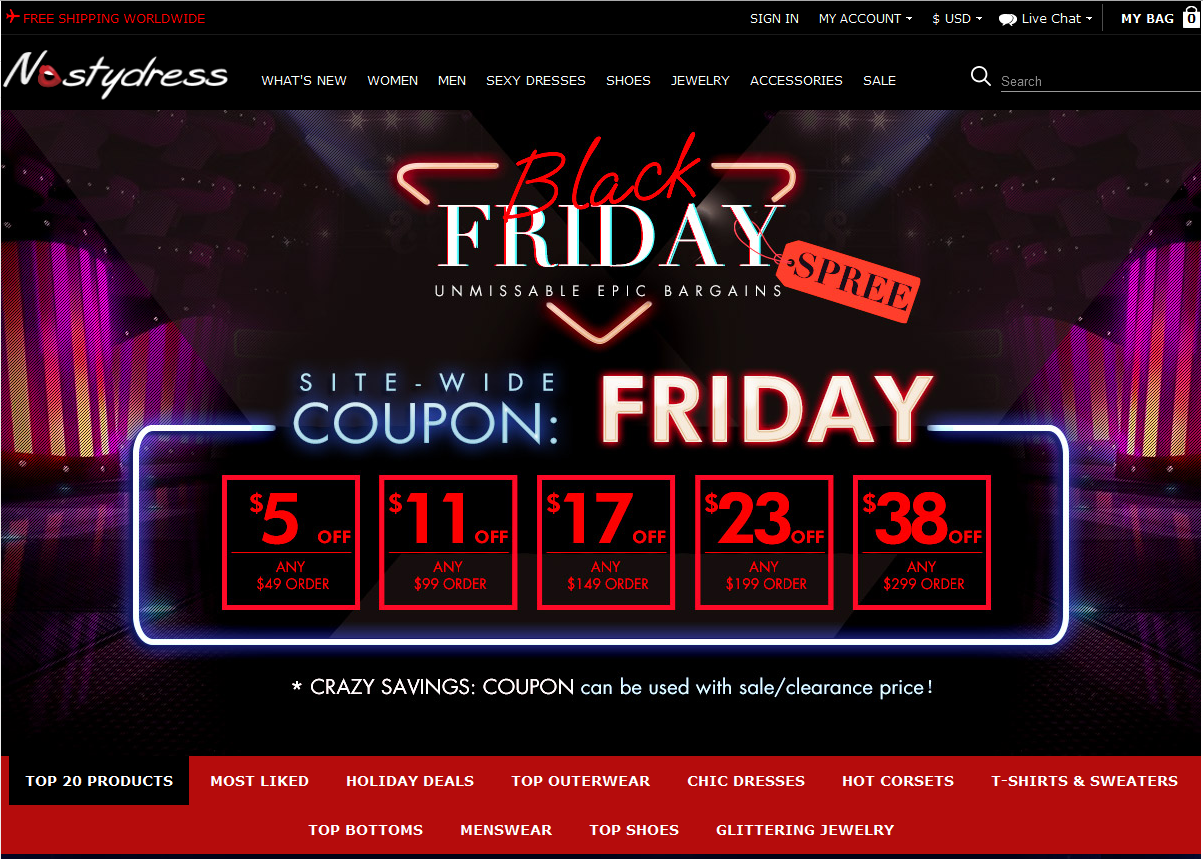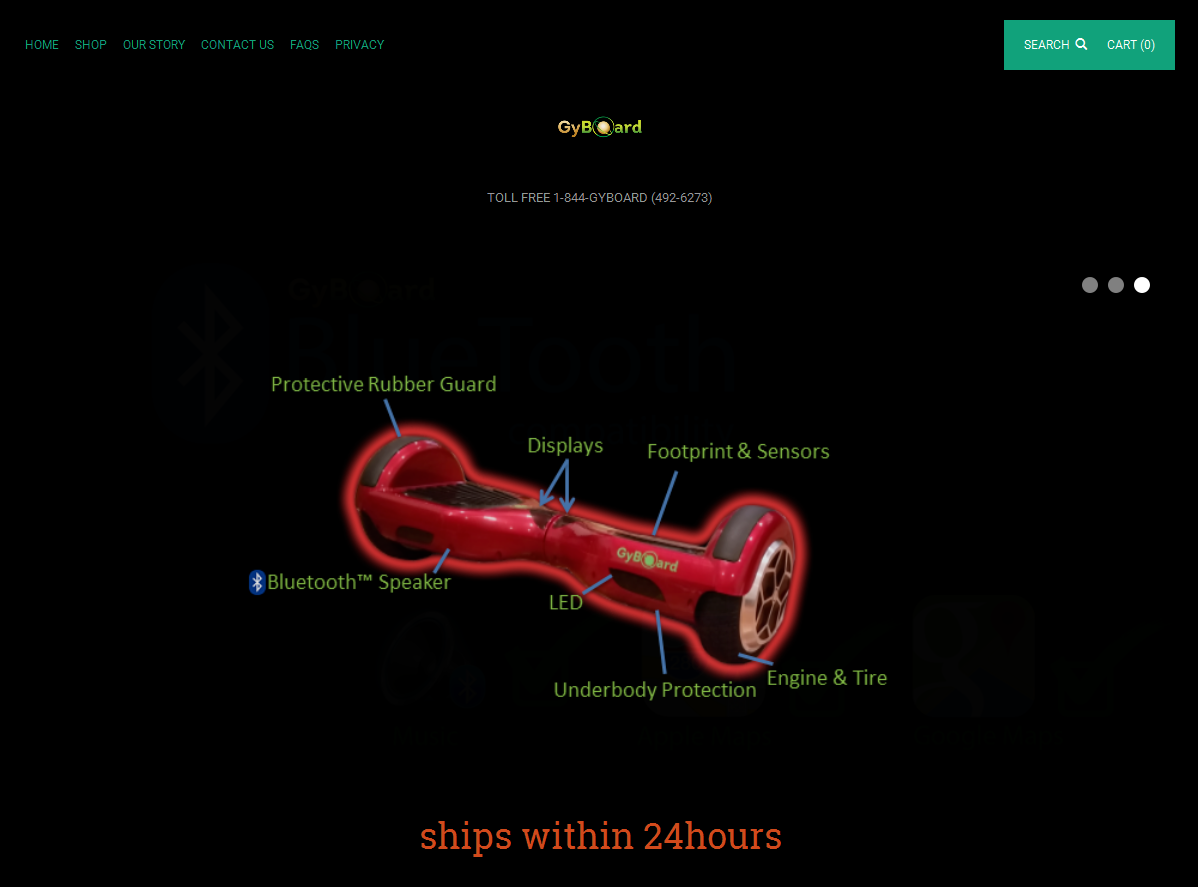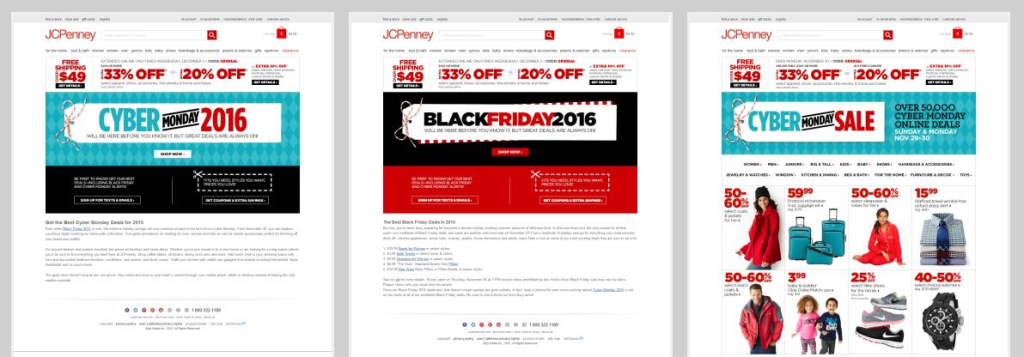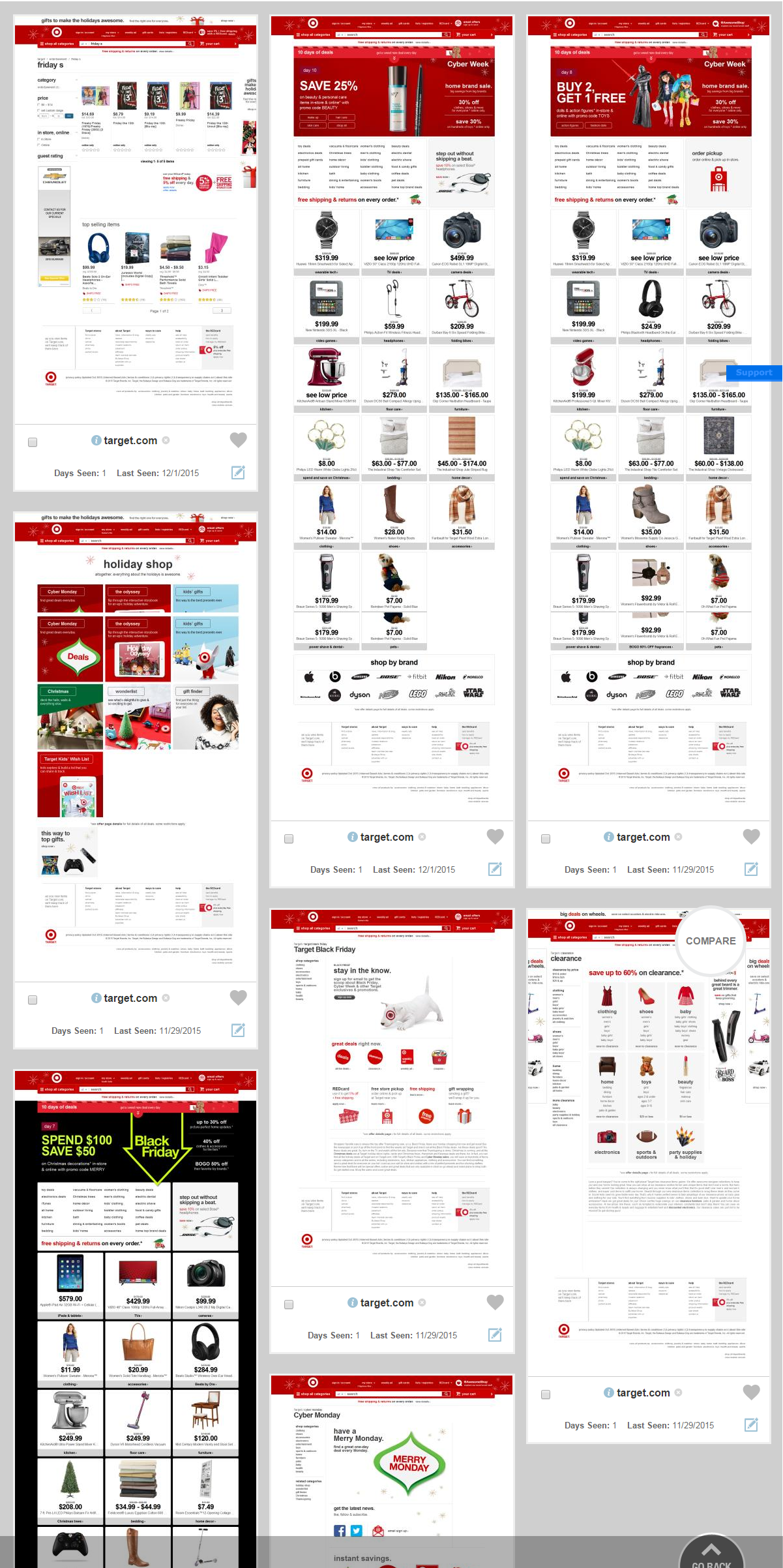Google Adwords sits on the middle to the bottom of the funnel for most marketing campaigns.
Normally, prospects go to the Google search bar and type in a search term because they have a problem they want to solve. Therefore, if your product solves that problem, you’ll have a good chance of converting the traffic.
It also means that the most converting keywords usually connect to a finite set of terms since there are only so many people searching for your product or service each month.
But there are a few occasions where people are willing to hand their credit card over to you even though their search terms are not directly related to your product. Black Friday and Cyber Monday are two of those times.
On both of those days, people search for terms like “black friday sales” or “cyber monday sales” and are looking for the best deals, not one specific product or service, and they’re ready to spend money if they see a really, really good deal.
The Research Method
To study PPC campaigns for these days, we analyzed the following search phrases between Friday the 27th to Wednesday December 2nd:
- Black Friday
- Cyber Monday
- Black Friday sale
- Cyber Monday sale
We then analyzed 100 landing pages associated with these terms.
As you can see from the image below, the search volume for these keywords surged during the November time frame, increasing from under 1M from January through September to nearly 20M searches in November.

Based on this data, we thought it would be interesting to see which companies took the opportunity to boost their holiday season’s revenue with ads and landing pages targeted specifically towards Black Friday and Cyber Monday sales.
NOTE: We did not click on any of ads while writing researching for this post. Instead, our competitive intelligence technology allows us to go to the landing pages without costing clicks to the advertiser’s AdWords account. Thus, to come up with this report, we did not cost the advertisers a single dime.
We also used a fairly simple criteria to come up with the results:
- The overall landing page design, i.e. which company stands out the most.
- The offer, i.e. which companies offered the best deals.
- The keyword, ad copy, and landing page continuity, i..e how seamless the customer journey was.
The Best Performers
Nastydress
Landing Page Version 1

Landing Page Version 2

Nastydress.com’s landing pages stand out the most among the other landing pages that we observed.
They matched the “black” in “Black Friday” with the dark, neon style design. Their web design also evokes a naughty emotion for Black Friday, which is perfect for what they’re selling—sexy clothing.
On top of that their page copy matches up with what people are looking for—Black Friday discounts.
Furthermore, they throw in a seemingly awesome deal of 80% off for their Cyber Monday campaign.
Let’s use iSpionage to analyze their customer journey a bit further:

Our competitive intelligence data shows that when searchers typed in “cyber monday,” they saw ad copy from Nastydress which uses “Cyber Monday Online” as the headline and 80% off with free shipping for 10,000 products. Awesome! I’m definitely interested in seeing more since it matches exactly what I was looking for!
When you click on the ad, you land on a nicely designed landing page with “80% Off” front and center, which means the continuity from keyword to ad to landing page is flawless.
Bravo, Nastydress! This is what a good PPC campaign should look like!
American Eagle (AE.com)

The Good:
American Eagle’s landing page evokes a beautiful winter emotion, and when the visitor lands on this page they immediately see the 50% OFF offer.
Further Analysis:
From the customer journey perspective, American Eagle provides decent continuity (as seen below).

The keywords triggered ad copy with the right headline and an interesting 40% off offer. Visitors then land on an attractive landing page with a 50% discount.
But wait a minute. Is the discount 40% or 50%? The ad says 40%, but the page says 50%. Which is it?
The lesson here is that if you’re offering a 50% discount, then you should communicate that with your PPC manager or agency so the ad copy reflects exactly the same thing and doesn’t confuse visitors by offering different discounts, not too mention you’ll get more clicks by advertising a deeper discount in search results.
This was definitely a missed opportunity for American Eagle. We give them a high score for landing page design and an average score for keyword, ad copy, and landing page continuity.
SAMMYdress
Landing PageVersion 1

Landing Page Version 2

SAMMYdress tested two different landing pages. One directed traffic to a page with a “Cyber Monday” theme and an 85% off offer.
The second version is not as flashy and landed visitors on the category page where visitors can quickly see all of the deals that are offered on the site.
The problem with the second version, the one without the big splash banner, is that visitors are just two clicks away from seeing similar offers from most retailers out there, so it doesn’t stand out as much as the first version.
Further Analysis:
Similar to the American Eagle’s problem above, we’re now starting to see a pattern of disconnection in the customer journey.
The ad copy, as seen below, offers “80% off” and another ad copy variation offers “50% off” while the landing page actually showed “UP TO 85% OFF.” What’s up with that?

This happens when the PPC manager and the product marketing manager don’t communicate regularly before the launch of a sales event like Black Friday or Cyber Monday.
Bodybuilding.com

Bodybuilding.com’s landing page stands out with an eye-catching super-human graphic theme.
The 20% offer, though, isn’t that sexy.
When people are on the edge with their credit card at hand, you should do everything you can to convert them, including the best possible deals and offers.
Another trick is to do what the other advertisers have done and to offer an “up to X%” discount where not all of your products are 50%-80% off but some of them are. This gets visitors into buying mode and gets them ready to buy when they see a deal they like.
Here’s what the complete flow looked like:

In terms of customer journey, this is a good experience with the keyword, ad, and landing page all aligned.
Nice work Bodybuilding.com!
Gyboard.com

GyBoard had the most unique offer out of all the Black Friday and Cyber Monday deals we saw.
Clothing, electronics, and accessories are something that many internet retailers offer, but GyBoard’s product is really cool. It’s a motorized, self-transportation device and is a one of a kind product that’s unique and exciting.
If they sweetened the deal by just a little bit, let’s say with a 25% off offer, it would have been the most attractive offer out there, which means they missed an opportunity to move some extra units.
Let’s take a look at the customer journey to see how well they did on that front.

Once again, this is a missed opportunity.
The ad copy mentions a $299 Cyber Monday sale, but there’s no mention of the sale on the landing page. Instead, this kind of offer should be front and center when shoppers land on the website in order to entice them to make a purchase.
GyBoard is an awesome and unique product, which is perfect for a Cyber Monday type of sales event, but when you expect a $299 deal and don’t see that on the landing page, suddenly your interest level goes down because if there is no deal, you can just wait for any other day to buy the board.
The Bad & The Ugly
My mom once told me that, “If you don’t have anything nice to say about a person, you better not say anything.”
Well, sorry mom, but I need to call out a few negative examples so we can all learn something the next time around.
Uniqlo.com

Here’s the complete flow that triggered this landing page:

Let’s think about this from the customer journey perspective.
The customer typed “black friday sale” into Google and were served an ad that says “Uniqlo Cyber Monday.”
Hmm…that’s not a very good match.
Then when you click on the ad, you land on the landing page that doesn’t immediately say anything about a Black Friday or a Cyber Monday sale. Even worse, before you can see anything on the page, you’re asked to fill out a form that promises “some perks.”
What kind of perks? Can you at least specify what “perks” means? Is it a discount? A cookie in the mail? Something else?
I personally would click the “back button” right away if I saw this pop up that promised me nothing while I’m in extreme buying mode.
Too bad Uniqlo, you may have missed a huge opportunity on this year’s event.
The Extra Effort Category
I understand that sometimes you have to just work with what your company sells and can’t be too creative about the product or the discount you offer because creating different offers and landing pages are a time consuming, resource-heavy, type of activity. So I want to show you how the big companies, the ones that have virtually no resource restraint, do it.
Macys.com
Macy’s camed up with four different landing pages just for this occasion:


JCPenney.com
The JCPenney team came up with three landing pages for Black Friday and Cyber Monday.

Target.com
Target’s team went all out and used 8 different landing pages for Black Friday and Cyber Monday.

Wrapping It Up
As a marketer, it’s your job to know what you can do to get as much exposure as possible.
If your target market is consumers, then tying your search marketing campaign to sales events is definitely worth it. Birthdays, Mother’s Day, Father’s Day, Black Friday, Cyber Monday, and Christmas are just some of the generic events where shoppers have a strong purchase intent, so make sure to build these into your overall PPC campaign plan.
Once you have that strategy in place, then you need to execute it right to get the best results. You need to coordinate with all of the stakeholders that have the capacity to influence the customer buying process to ensure there’s a good continuity between the keyword, ad, and landing page being used.
As you can see in this post, there were quite a few missed opportunities due to miscommunication between the product marketer, web designer and/or the PPC manager.
The good news is that you don’t even have to be super high tech about this. Just make sure there’s an email thread that involves all of the stakeholders with a simple checklist before launching the campaign. Here’s sample list of questions that you can circulate before launching one of these types of PPC campaigns.
- Is the offer strong enough?
- Is the page design attractive enough for our customers?
- Does the offer AND page design stand out compared to the competition?
- Does the ad copy match the offer on the landing page?
- Does the keyword, ad copy, and landing page have a flawless continuity?
If you follow this checklist and make sure everyone’s on the same page, you’ll increase your chances of pulling off a successful Black Friday, Cyber Monday, or any other seasonal sales event.
Lastly, just to make sure I don’t get called as a click fraudster, I need to mention this again: all of the data and screenshots in this post are gathered using iSpionage Campaign Watch, without clicking a single one of the ads.
And don’t forget to visit our homepage if you’d like to give our technology a test drive and try iSpionage out for free!
About the Author
 Leon Krishnayana is the founder and CEO of iSpionage.com. iSpionage provides market intelligence data to help businesses and agencies come up with a stand-out, high-converting digital marketing strategy, specifically for improving search engine marketing (SEM) campaigns.
Leon Krishnayana is the founder and CEO of iSpionage.com. iSpionage provides market intelligence data to help businesses and agencies come up with a stand-out, high-converting digital marketing strategy, specifically for improving search engine marketing (SEM) campaigns.











